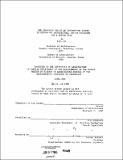| dc.contributor.advisor | Eric Dluhosch. | en_US |
| dc.contributor.author | Liu, Lu, M.S. Massachusetts Institute of Technology | en_US |
| dc.contributor.other | Massachusetts Institute of Technology. Dept. of Architecture. | en_US |
| dc.date.accessioned | 2013-01-07T21:08:58Z | |
| dc.date.available | 2013-01-07T21:08:58Z | |
| dc.date.copyright | 1985 | en_US |
| dc.date.issued | 1985 | en_US |
| dc.identifier.uri | http://hdl.handle.net/1721.1/75958 | |
| dc.description | Thesis (M.S.)--Massachusetts Institute of Technology, Dept. of Architecture, 1985. | en_US |
| dc.description | MICROFICHE COPY AVAILABLE IN ARCHIVES AND ROTCH. | en_US |
| dc.description | Includes bibliographical references (leaves 84-85). | en_US |
| dc.description.abstract | This thesis is to illustrate how a computer-based information system for supporting decision making, that is a Decision Support System (DSS), can be utilized as a strategic tool in architectural design for a firm. The products of information technology have been designed around a wide spectrum of needs. Architects can immediately adopt the technology and use it as design tools. These tools are not just a productional convenience, but also bring about strategic advantages to a firm. In this study, through the investigations on the current computer use in professional architectural design , a need is called out for DSS planning. Derived from the field of Management Information Systems, a method of strategic DSS planning is set forth, which is a top-down planning process from office strategy to data base requirements, with the emphasis on the most critical applications to the top management . This method is applied through a three - phase planning process to a hypothetical office which represents a typical design firm. It is found in this study that the construction cost analysis for schematic design phase is the key operation for a DSS. This DSS can forge strong links between architectural design, project management, and office strategy in establishing a firm's competence in the cost and quality control for a building. | en_US |
| dc.description.statementofresponsibility | by Liu, Lu. | en_US |
| dc.format.extent | 85 leaves | en_US |
| dc.language.iso | eng | en_US |
| dc.publisher | Massachusetts Institute of Technology | en_US |
| dc.rights | M.I.T. theses are protected by
copyright. They may be viewed from this source for any purpose, but
reproduction or distribution in any format is prohibited without written
permission. See provided URL for inquiries about permission. | en_US |
| dc.rights.uri | http://dspace.mit.edu/handle/1721.1/7582 | en_US |
| dc.subject | Architecture. | en_US |
| dc.title | The strategic use of an information system in supporting architectural design decisions for a design firm | en_US |
| dc.title.alternative | Architectural design decisions for a design firm, The strategic use of an information system in supporting | en_US |
| dc.type | Thesis | en_US |
| dc.description.degree | M.S. | en_US |
| dc.contributor.department | Massachusetts Institute of Technology. Department of Architecture | |
| dc.identifier.oclc | 13172727 | en_US |
